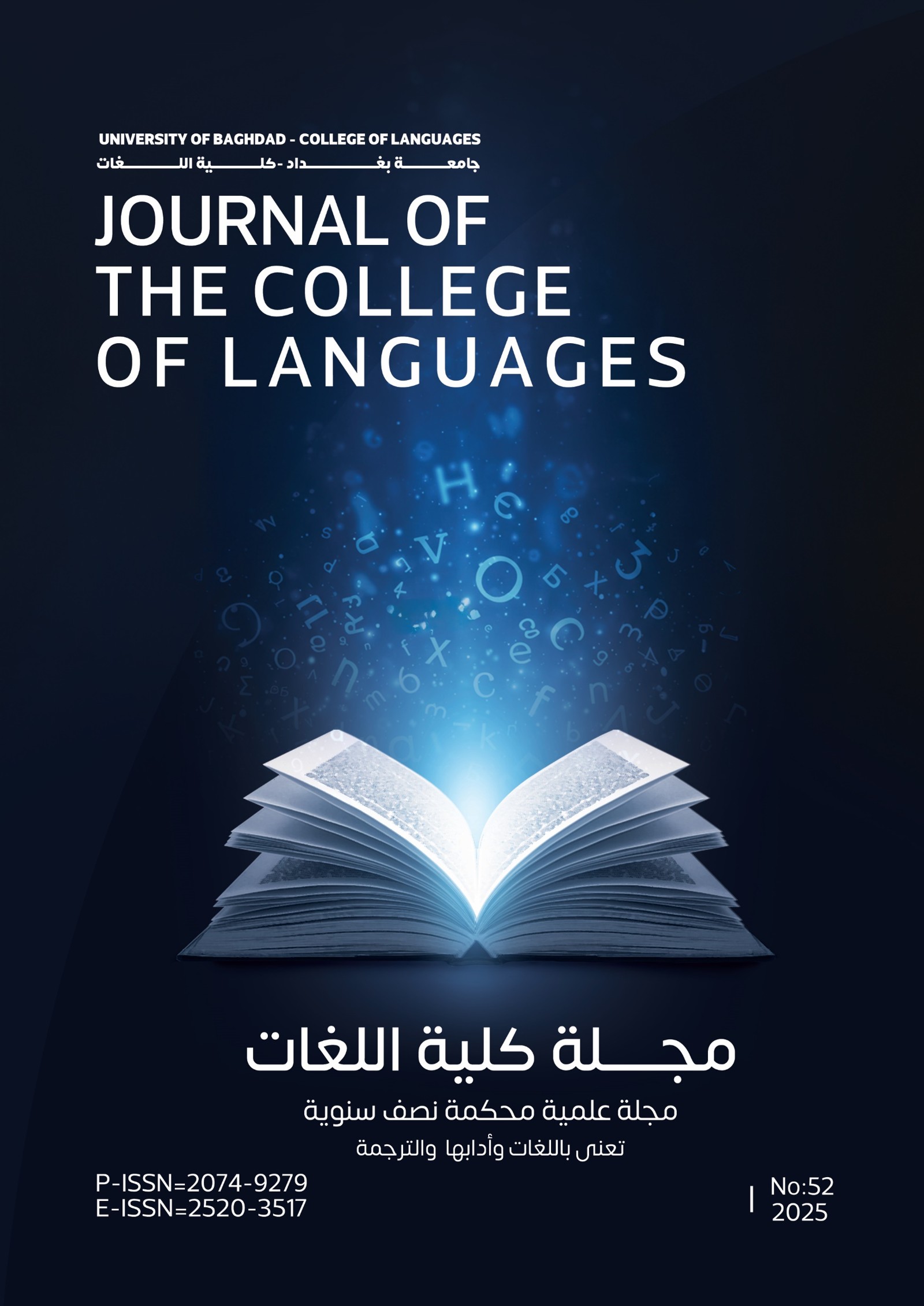Word-Formation System And Its Influence On The Translation Of New Vocabulary In Russian And Arabic
Словообразовательная Система И Ее Влияние На Перевод Новой Лексики В Русском И Арабском Языках
DOI:
https://doi.org/10.36586/jcl.2.2022.0.45.0210Keywords:
Derivational word formation process; translation; new vocabulary; translation equivalence; motivation; root; affix., словообразование; перевод; новая лексика; переводческая эквивалентность; мотивация; корень; аффикс.Abstract
Derivational word formation process is one of the most substantial linguistic procedures that solves many problems in the translation of the language new vocabulary and helps to comprehend the smallest language component that not simply semantically and structurally explain the elements of both Russian and Arabic but also enables translators to comprehend the derivational method procedures of both languages. It also reveals the structural aspects of translation equivalences, cognitive and semantic foundations of translation. The rapid development of languages and the appearance of a new vocabulary like ṭabaʿa "print → ṭābiʿat "printer", kataba "to write" → kātib → kātibat, rafaʿa "to raise" → rāfiʿat "a crane" dictate its own terms, binding both linguists as well as translators to discover a new methods of the resolving complications of translation equivalences.
The interaction happening between the derivational word process and translation provides an exceptional prospect to grasp the language words structure that regulates the smallest word components of both languages. Structure and semantics are involved in the construction of minimal significant elements, which makes it possible to understand the new vocabulary patterns to achieve translation equivalence.
Аннотация
Словообразовательная система является одной из важных систем лингвистики, изучение которой решает много переводческих проблем новой лексики. Рассмотрение особенностей словообразования как важной языковой подсистемы дает нам понять мельчайшие значимые языковые элементы. Эти элементы не только поясняют структуру и семантику производных слов русского и арабского языка, но и дают переводчикам возможность понять, как действуют словообразовательные процессы обоих языков. На основе словообразования, раскрываются структурные стороны переводческой эквивалентности, когнитивные и семантические основы перевода. Бурное развитие языка и появление новой лексики типа ṭabaʿa "напечатать → ṭābiʿat "принтер", kataba "писать" → kātib → kātibat, rafaʿa "поднимать" → rāfiʿat "подъемщик" диктуют свои условия, обязывающие не только лингвистов, но и переводчиков найти новые основы для решения проблемы переводческой эквивалентности.
Взаимодействие словообразования и перевода дают уникальную возможность понять структуру слов языка, что выясняет минимальный значимый состав слов обоих языков. Структура и семантика участвуют в строении минимальных значимых элементов, что дает возможность понять состав новой лексики и как достичь переводческой эквивалентности.
(Received on 1/2/2021 - Accepted on 15/3/2021 - Published on 2/1/2022)
References
- -Al'-Foadi R. A., Zarytovskaya V. N. K voprosu o vnutrennej fleksii kornej v arabskom i russkom yazykah (flektivnyj analiz struktury kornya) // Izv. Sarat. un-ta. Nov. ser. Ser. Filologiya. ZHurnalistika. 2019. T. 19, vyp. 3. S. 268–275.
- -Belkin V. Arabskaya leksikologiya. M.: Izdatel'stvo Moskovskogo universiteta, 1975. 201 s.
- -BES – Bol'shoj enciklopedicheskij slovar'. YAzykoznanie / gl. red. V. N. YArceva. 2-e izd. M., 1998. S. 242.
- -Vinokur G. O. Zametki po russkomu slovoobrazovaniyu // Izbrannye raboty po russkomu yazyku. M.: Uchpedgiz, 1959. S. 419 – 442.
- -Girgas V. F. Ocherk grammaticheskoj sistemy arabov. SPb.: Tir. Imp. Akad. nauk, 1873. 138 s.
- -Grande B.M. Kurs arabskoj grammatiki v sravnitel'no-istoricheskom osveshchenii. 2-e izd. – M.: Vostochnaya literatura RAN, 2001. – 592 s.
- -De Sossyur, F. Kurs obshchej lingvistiki // Trudy po yazykoznaniyu. – M.: Progress, 1977. – 696 s.
- -Kubryakova E.S. Slovoobrazovanie / Lingvisticheskij enciklopedicheskij slovar', Gl. red. V. N. YArceva. - M. : Sov. enciklopediya, 1998. - 682,
- -Kubryakova E.S. Tipy yazykovyh znachenij: Semantika proizvodnogo slova. — M.: Nauka, 1981. 200 s.
- -Lopatin V.V., Uluhanov I.S. Slovar' slovoobrazovatel'nyh affiksov sovremennogo russkogo yazyka. M.: Azbukovnik, 2016. 812 s.
- -Ovchinnikova, A. N. Lingvodidaktika slovoobrazovaniya v teoreticheskom aspekte russkogo yazyka kak inostrannogo // Lingvodidaktika : materialy VI Resp. nauch.-prakt. seminara, Minsk, 25 okt. 2019 g. / Belorus. gos. un-t ; redkol.: S. I. Lebedinskij (gl. red.) [i dr.]. – Minsk : BGU, 2019. – S. 62-68.
- -Potebnya A.A. Iz zapisok po russkoj grammatike. T. 4 / A.A. Potebnya; AN SSSR, Otdnie lit. i yaz. — M.: Uchpedgiz, 1958. — 536 s.
- -Raciburskaya L.V. Rossijskaya slovoobrazovatel'naya nauka v XXI veke // Rusistika. 2019. T. 17. № 3. S. 276–299.
- -Serebrennikov B.A. O prichinah ustojchivosti agglyutinativnogo stroya / / Voprosy yazykoznaniya. - 1963. - №1.C. 46-57.
- -Alexis A.N. – Laporte, E. Pattern-and-root inflectional morphology: the Arabic broken plural. Language Sciences. Britain: Elsevier, 2013. pp. 221-250.
- -Al-Foadi R. A., N. G. Mingazova. The three-level phono-grammar order and its derivational connecting link: The elements of language system (on the material of Arabic). XLinguae 11.4.2018.Pp. 59-77.
- -Al-foadi R.A. Derivation as the main way of adapting new terms to Arabic: Modern Journal of Language Teaching Methods (MJLTM), 2018. Vol. 8, Issue 3, 175-180.
- -Baker M. “Corpora in translation studies: an overview and some suggestions for future research”. Target 7, 2. 1995: 223-243.
- -Baker M. 1987. Review of Methods Used for Coining New Terms in Arabic. In: Meta 322, pp.186–188. ISSN: 0026-0452.
- -Baroni M. & Bernardini, S. “A new approach to the study of translationese: machine-learning the difference between original and translated text”. Literary and Linguistic Computing 21, 3. 2006. 259-274.
- -Al-āṣmʿī ʿbd al-mlk bn qrīb. ktāb al-āštqāq. bġdād.: mṭbūʿāt al-mǧmʿ al-ʿlmī al-ʿrāqī, 1968. 51 ṣ. [Al Asmai Abdul Malik bin Qrīb. The Book of Derivation. Baghdad: Publications of the Iraqi Academy of Sciences, 1968. 51 p.]. (Original in Arabic).
- -īāqūt aḥmd slīmān. abḥāṯ fī al-lġẗ. al-āskndrīẗ.: dār al-mʿrfẗ al-ǧāmʿīẗ, 1994. 60 ṣ. [Yakut Ahmed Suleiman. Researches in Language. Alexandria: dār al-mʿrfẗ al-ǧāmʿīẗ, 1994. 60 p.]. (Original in Arabic).
- -Al-nāʾilẗ ʿlwān ʿbd al-ǧbār. al-ṣrf al-wāḍḥ. bġdād.: ǧāmʿẗ bġdād, 1988. 464 ṣ. [Nayla Alwan Abdul-Jabbar. Clear Morphology. Baghdad: University of Baghdad, 1988. 464 p.]. (Original in Arabic).








